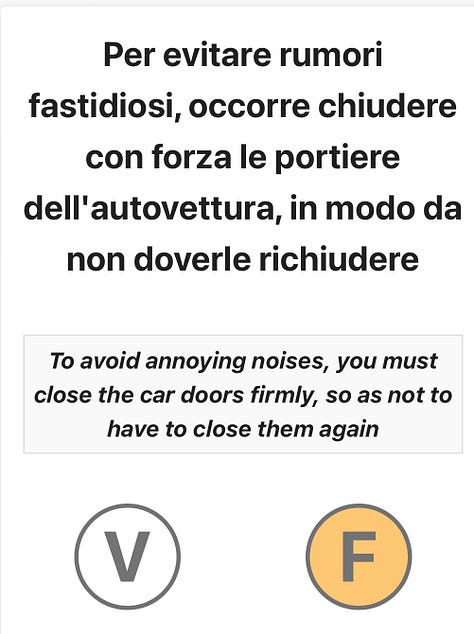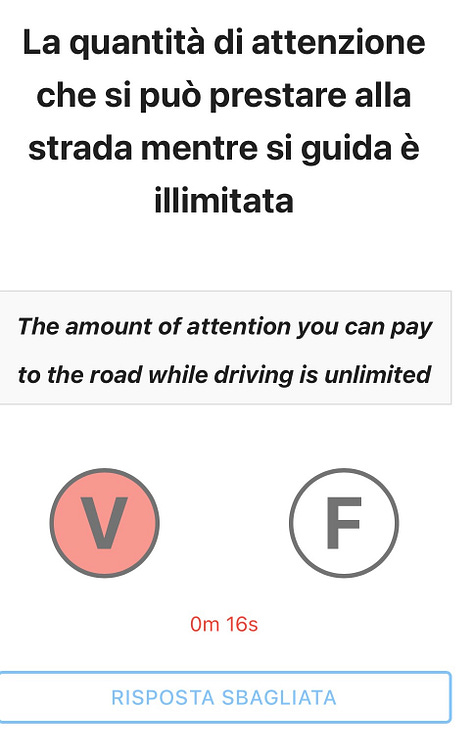Tuscany has been my playground since 2022. Ever since I made the move, friends back in Canada keep asking, “So what’s the deal with retiring in Italy? How’d you pull it off? What are the steps?”
So I thought, why not share what it's truly like? In this newsletter, I’ll offer a glimpse into the lesser-seen side of Italy: the maze of bureaucracy that often underlies its sun-drenched charm. The leap into la dolce vita can come entangled in red tape. But with enough persistence and patience, it’s entirely possible to navigate. Consider this your first taste of the reality behind the postcard-perfect allure.
What follows is simply my experience, a personal account, not a prescription. Before embarking on any life-altering move, seek guidance from those qualified to give it. I claim no expertise. I only lived the story I’m about to tell.
What’s Driving Your Move?
Your reason for relocating shapes everything that follows.
Maybe you’ve been enchanted by Italy on vacation and want a deeper experience. Or perhaps you’ve decided this is it, your retirement destination. Either way, your approach will look very different depending on whether you're a part-time adventurer or a full-time expat.
Just Here for a Fling?
You’re in luck. If you’re Canadian or American, you can stay in Italy for up to 90 days without a visa, thanks to the Schengen Agreement.
No government paperwork required. Just make sure you have solid travel and medical insurance. That’s it. Easy.
Thinking Long-Term?
...then it’s time to roll up your sleeves.
If you want to stay more than 90 days, you’ll need a visa. In most cases, that means the Elective Residence Visa, ideal if you’re moving for retirement or lifestyle reasons (not for work or study).
Make an Appointment (Yes, Early!)
Visa applications are done in person at your local Italian consulate. In my case, it was Montreal.
You must book online. No walk-ins allowed. And book early, wait times can be long.
Here’s what they asked for when I applied:
A valid passport (at least 3 months beyond your visa’s expiry)
The visa application form
Passport photos
Proof of accommodation (rental agreement or property deed)
Proof of sufficient income (usually around €31,000+ per person per year—pension, savings, investments, etc.)
Health insurance that works in Italy for your entire stay
A flight itinerary (not necessarily a paid ticket)
A cover letter explaining why you’re going and what you plan to do
The consular fee (around $200)
Show Up Prepared
Bring everything, originals and copies. Italians might not be known for punctuality, but you should be. If you miss your appointment, they’ll likely make you rebook and start again.
Hurry Up and Wait
Once your documents are submitted, the waiting game begins. Mine took a few weeks but it can take longer.
Welcome to Italy
I was fortunate, serendipity, or perhaps just Italy at work. A good friend of a good friend (naturally, this is how things unfold here) happened to be an emigration lawyer. Over a lingering hour and a few espressos at the local bar, he generously shared the intricate ins and outs of settling in Italy. That quiet conversation spared me countless hours of aimless queueing and dead-end phone calls. In a country where relationships often matter more than forms, this chance encounter was a small, essential grace.
In a nutshell, once you arrive, within 8 days you must:
Go to the local post office and ask for the Permesso di Soggiorno kit. Fill it out and submit it with most of the same documents from your visa application. There is a fee of around €200 if I remember right.
Book a follow-up at the Questura (police HQ) for fingerprints and processing.
Once you have your permesso (or even just the receipt), go to the Anagrafe (town registry) to register your address. Bring proof of residence and all documents.
In my case, a Carabiniere (local police) actually came to my home to verify I lived there. That was... unexpected.
The entire process took about nine months.
The Permesso di Soggiorno is valid for 1–2 years and can be renewed.
After 5 years of legal residency, you can apply for a long-term EU residence permit. After 10 years, you may be eligible for Italian citizenship.
I was lucky, I was born in Italy, so I reclaimed my citizenship and got an Italian passport. That process took about a year, and aside from the laid-back attitude, it was fairly straightforward.
Healthcare – A (Pleasant) Culture Shock
Once my residency was approved, I was assigned a family doctor. I was given a few options to choose from, and within just three days, I had my first appointment.
To my surprise, the doctor spent nearly an hour with me, not just reviewing my medical history, but asking about my life, my background, what had brought me here. It felt more like a conversation than a consultation.
Before I left, he handed me his personal cell number and told me to call anytime. I was taken aback. Back home, that kind of care, so personal, so human, felt almost unheard of. And just before I walked out the door, he smiled and said, “Send me your newsletter. I’d love to follow along.” So now, my doctor is also a reader.
You’ll also receive a Carta d’Identità (ID card) and Codice Fiscale (tax number, similar to a SIN). With those, you can do almost everything, banking, contracts, utilities, you name it.
Opening a bank account wasn’t too bad, though I did have to sign what felt like an endless stack of forms, until my hand started cramping.
Driving: AKA My Italian Nightmare
This was, hands down, the most frustrating part of legalizing my residency.
Canada and Italy don’t recognize each other’s licenses. After one year of residency, my Canadian license was useless.
My only option? Italian driving school.
Sure, I could’ve self-studied and taken the theory exam. But after hearing enough horror stories, I went all-in: 40 mandatory classes, 300 practice quizzes, six hours of driving lessons. Price tag: €1,100.
Did it teach me to drive? Nope. But it taught me something very Italian, how to survive absurdity.
You learn to stop thinking logically and start thinking like them. “Where’s the trap in this question?” became my motto. Once I reframed the test that way, it started to make sense, sort of.
It’s not driving school, it’s mental boot camp. Italians grow up with this, twisting, doubting, second-guessing. It’s a national sport.
Used to efficiency and logic? È un incubo. A total nightmare.
Here are a few questions straight from a quiz.



The Real Life Stuff
Language: It’s Italian or Bust
Outside of tourist zones, you’ll need Italian. Bank accounts, town halls, contracts, it’s all in Italian. Learn the basics or bring a fluent, patient friend.
Housing: Gorgeous, But Don’t Expect Speed
Looking around Tuscany?
Rentals (2-bedroom, small village): €600–€1,000/month
Modest home (1,000 sq ft): €200,000–€600,000
Countryside villa with a view: Around €1 million—or much more.
Yes, there are plenty of beautiful country homes in Tuscany that need full renovation. Under the Tuscan Sun is a Hollywood movie, don’t forget that. Many abandoned homes aren’t even for sale, and negotiations can take months, or years. Renovation permits can take up to two years to secure.
Be warned: Urgency surrendered long time ago . Agents aren’t aggressive. You’ll have to chase them. My first rental took three months to finalize. I once annoyed an agent by asking to see a house “the next day”, he was busy harvesting grapes.
In Montreal, I rented my place in two hours. Visit, credit check and signed lease.
Final Thoughts
Ask yourself: do you want the Italian life, or just the vacation?
If you fall in love with the lifestyle, there’s so much to gain. But you’ll need to adapt. Don’t compare everything to the Canadian or American way, or you’ll be on the next flight home.
You’ll question everything: yourself, your choices, the meaning of time. But if you hang in there, something shifts. The red tape thins. The espresso hits. The sunsets forgive the unpunctuality.
💡 A Few Tips
Hire a bilingual lawyer or relocation expert. Worth every penny.
Travel around, each region has a different vibe. I chose Tuscany, but explore.
Learn basic Italian. Seriously.
Join expat groups, Facebook has tons.
Don’t expect things to happen on time. Follow up. Nicely, but often.
Italians are warm, generous people. But if they don’t want to help, you can’t force them. You’ll learn to let go.
Eventually, you’ll start living more like them. I know I’m calmer now. That hustle mentality I had back in Canada? It’s pretty much gone. Now, I go with the flow more.
I often find myself reflecting on the experience of it all, the unexpected poetry woven into the process. The casual conversations with the post office clerk about nothing in particular, as a long queue waited without protest. The doctor unbothered by the line of patients in the hallway, choosing presence over punctuality. The lawyer, generous with his time and espresso, offering guidance without a clock ticking. The government officer who insisted on a photo with me, my new passport in hand, as if celebrating a shared victory. And the driving instructor, teasing underdressed students on a rainy day with the ease of an old friend. Compared to a more systematic, by-the-book approach, where everything runs like clockwork, well, if I could only have one, I think I’d still choose the mess, the humanity, the quiet charm of it all.
In bocca al lupo*








Hi Tino, you successfully managed the process and now you are an Italian citizen, again😊. It is not easy to make a move like you have, I’m sure it can be quite scary to undertake such a life change. As you know, we are visiting Tuscany again this September, and then travelling south. The time we spent in Tuscany last year, and with you, has made Lis and me want to do it over again. This time we are bringing another couple with us, so I can show our country off to them. You do inspire.
Great summary and a fun read. Even though my expat home is in Portugal, I love reading your take, and I can truly relate. A Portuguese version of becoming an expat would have most of the same elements with a slightly different twist... and a more frustrating language!